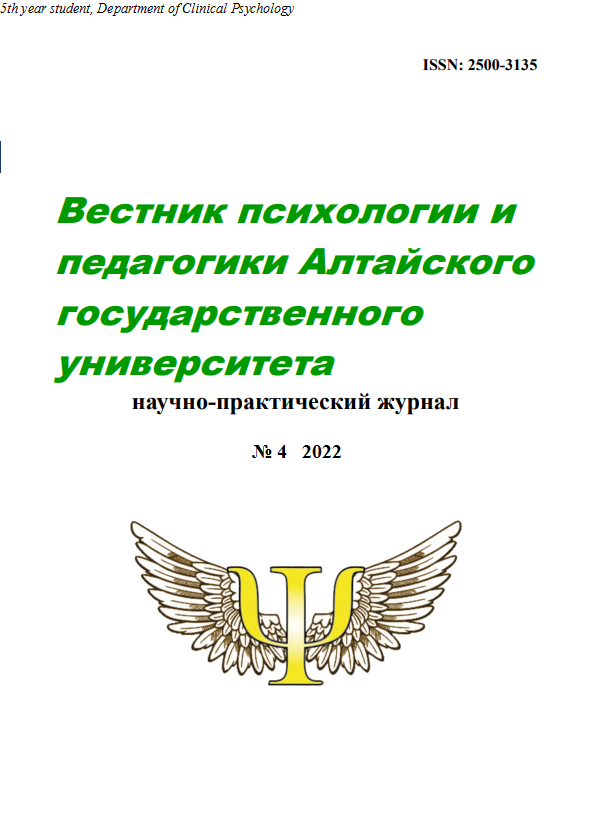G. LE BON AND G.TARDE ABOUT «EMOTIONAL INFECTION» PHENOMENON
УДК 159.9.019.2
Abstract
The article is devoted to the study of the problem of analysis and interpretation of the phenomenon of «emotional infection» in the context of the French tradition of structuralism. The relevance of the study is due to the need to rethink the classical works of the French psychologists G. Le Bon and G. Tarde, based on relatively recent discoveries in the psychology of the crowd, the socio-psychological mechanism for transmitting emotional mood and the forms of influence on a person of characteristic reactions of the mass. The aim of the study is a comprehensive analysis of the phenomenon of «emotional infection» on the example of the works of G. Le Bon «The psychology of the crowd», G. Tarde «The public opinion and the crowd» and modern research in this area. The study uses general scientific, psychological and sociological methods, among which the following should be highlighted. The result of the study is to determine the features of the relationship between the impact on the individual of the emotional concepts of mass consciousness and infection with them in the case when he experiences social insecurity and is in dire need of confirmation of the conformity of his feelings.
Downloads
References
Гончаров А.С. Истоки психоанализа. К 165-летию со дня рождения Зигмунда Фрейда // Актуальные научные исследования в современном мире. 2021. № 5–9 (73). С. 68–70.
Предвечный Г.П., Шерковин Ю.А. Социальная психология. Краткий очерк. М. : Политиздат, 1975. 320 с.
Chen J.Z, Qu Z., Wang C., Zhang D. Modeling adaptive empathy based on neutral assessment: a way to enhance the prosocial behaviors of socialized agents under the premise of self-security // Applied Intelligence. 2022. Vol. 52. No. 6. P. 6692–6722. URL: https://dl.acm.org/doi/abs/10.1007/s10489-021-02712-9
Dobson-Lohman E., Potcovaru A.M. Fake news content shaping the COVID-19 pandemic fear: Virus anxiety, emotional contagion, and responsible media reporting // Analysis and Metaphysics. 2020. Vol. 19. P. 94–100.
Freemantle A.W. J., Stafford L.D., Akehurst L., Wagstaff C.R.D. The Relationship Between Olfactory Function and Emotional Contagion // Chemosensory Perception. 2021. No. 11. URL: https://researchportal.port.ac.uk/en/publications/the-relationship-between-olfactory-function-and-emotional-contagi
Minton H.L. On the Origins of Crowd Psychology // Theory and Psychology. 1994. Vol. 4. No. 2. P. 290–292.
Paz LV., Milanesi B.B., Sulzbach J.H. Sulzbach [et al.] Contagious depression: Automatic mimicry and the mirror neuron system – A review // Neuroscience & Biobehavioral Reviews. 2022. Vol. 134. P. 104–509.
Rzymski P., Mamzer H., Nowicki M. The Main Sources and Potential Effects of COVID-19-Related Discrimination // Advances in Experimental Medicine and Biology. 2021. Vol. 1318. P. 705–725.
Simon P., Nader-Grosbois N. Preschoolers' Empathy Profiles and Their Social Adjustment // Frontiers in Psychology. 2021. Vol. 12. P. 500–782. URL: DOI 10.3389/fpsyg.2021.782500.
Le Bon G. Psychologie des Foules. Paris : Presses universitaires de France Collection Quadrige, 1895. 192 p.
Tarde G. L’opinion et la foule Gabriel. Paris : Felix Alcan, editeur, 1901. 226 p.
References:
Goncharov A.S. Istoki psihoanaliza. K 165-letiyu so dnya rozhdeniya Zigmunda Frejda // Aktualnye nauchnye issledovaniya v sovremennom mire. 2021. No. 5–9 (73). P. 68–70.
Predvechnyj G.P., Sherkovin Yu.A. Socialnaya psihologiya. Kratkij ocherk M. : Politizdat, 1975. 288 p.
Chen J. Z, Qu Z., Wang C., Zhang D. Modeling adaptive empathy based on neutral assessment: a way to enhance the prosocial behaviors of socialized agents under the premise of self-security / J. Chen, D. Zhang, Z. Qu, C. Wang // Applied Intelligence. 2022. Vol. 52. No. 6. P. 6692–6722. URL: https://dl.acm.org/doi/abs/10.1007/s10489-021-02712-9
Dobson-Lohman E., Potcovaru A.M. Fake news content shaping the COVID-19 pandemic fear: Virus anxiety, emotional contagion, and responsible media reporting // Analysis and Metaphysics. 2020. Vol. 19. P. 94–100.
Freemantle A.W.J., Stafford L.D., Akehurst L., Wagstaff C.R.D. The Relationship Between Olfactory Function and Emotional Contagion // Chemosensory Perception. 2021. No. 11. URL: https://researchportal.port.ac.uk/en/publications/the-relationship-between-olfactory-function-and-emotional-contagi
Minton H.L. On the Origins of Crowd Psychology // Theory and Psychology. 1994. Vol. 4. No 2. P. 290–292.
Paz LV., Milanesi B.B., Sulzbach J.H. Sulzbach [et al.]. Contagious depression: Automatic mimicry and the mirror neuron system A review // Neuroscience & Biobehavioral Reviews. 2022. Vol. 134. P. 104–509.
Rzymski P., Mamzer H., Nowicki M. The Main Sources and Potential Effects of COVID-19-Related Discrimination // Advances in Experimental Medicine and Biology. 2021. Vol. 1318. P. 705–725.
Simon P., Nader-Grosbois N. Preschoolers' Empathy Profiles and Their Social Adjustment // Frontiers in Psychology. 2021. Vol. 12. P. 500–782. URL: DOI 10.3389/fpsyg.2021.500-782.
Le Bon G. Psychologie des Foules. Paris : Presses universitaires de France. Collection Quadrige, 1895. 192 p.
Tarde G. L’opinion et la foule. Paris : Felix Alcan, editeur, 1901. 226 p.
Bulletin of Psychology and Pedagogy of Altai State University is a golden publisher, as we allow self-archiving, but most importantly we are fully transparent about your rights.
Authors may present and discuss their findings ahead of publication: at scientific conferences, on preprint servers, in public databases, and in blogs, wikis, tweets, and other informal communication channels.
Bulletin of Psychology and Pedagogy of Altai State University allows authors to deposit manuscripts (currently under review or those for intended submission) in non-commercial, pre-print servers such as ArXiv.
Authors who publish with this journal agree to the following terms:
- Authors retain copyright and grant the journal right of first publication with the work simultaneously licensed under a Creative Commons Attribution License that allows others to share the work with an acknowledgement of the work's authorship and initial publication in this journal.
- Authors are able to enter into separate, additional contractual arrangements for the non-exclusive distribution of the journal's published version of the work (e.g., post it to an institutional repository or publish it in a book), with an acknowledgement of its initial publication in this journal.
- Authors are permitted and encouraged to post their work online (e.g., in institutional repositories or on their website) prior to and during the submission process, as it can lead to productive exchanges, as well as earlier and greater citation of published work (See The Effect of Open Access).







